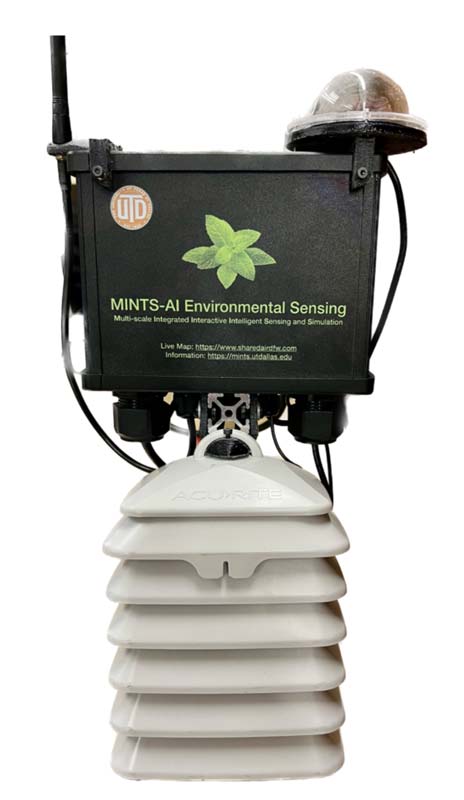Dallas College supports Air Quality Monitoring


Dallas College has a partnership with the
University of Texas at Dallas MINTS Lab (Multi-scale Integrated Intelligent Interactive Sensing Lab).
The partnership with UTD MINTS Laboratory is for Dallas College campuses and locations to serve as host sites for air quality monitors. The air quality monitors are built by the UTD MINTS Laboratory directed by Dr. David Lary and Research Associate Dr. Lakitha Wijeratne.
(Photo courtesy of The University of Texas at Dallas)
The funding for the research initiative is made possible by the
U.S. Department of Defense Accelerator for Innovative Minds (AIM). You can watch on YouTube how the UTD MINTS Laboratory features their technologies for
Phase 1 and
Phase 2 demonstrations. Phase 2 demonstration features the air quality monitoring programs.
UTD MINTS Laboratory air monitors have helped raise national and global awareness to local environmental justice issues,
receiving a BET Soul Train Award.
The air quality monitoring data can be observed on the public portal, known as the
Shared Air DFW Network. Shared Air DFW is a beginner-level educational information website to raise awareness of local air quality. Shared Air DFW shows air quality data from the UTD MINTS Lab air monitors, as well as air monitors from the Purple Air Network, air monitors from the Texas Commission on Environmental Quality (TCEQ), and the United States Environmental Protection Agency (EPA).
Dallas College has UTD MINTS Lab air quality monitors at the following locations:
- Brookhaven Campus
- Coppell Center
- Eastfield Campus
- Richland Campus
It is important to note that because this project with UTD MINTS Lab is a research project, sometimes the air quality monitors are not working properly and must be re-calibrated or re-started.
Additionally, the air quality data displayed may not be from pollution. Sometimes the increase in particulate matter (PM) is from natural weather events like sand from the Sahara Desert that usually arrives by wind in the north Texas region every summer.
In 2023, Dallas College will be installing 10 more UTD MINTS air quality monitors at the following locations:
- Administrative Office
- Bill J. Priest Center
- Cedar Valley Campus
- Downtown Health Sciences Center
- Garland Center
- Irving Center
- Mountain View Campus
- Pleasant Grove Center
- Service Center
- West Dallas Center
Dallas College collaborates for Air Quality Research and Teaching
In addition to the partnership with UT Dallas, Dallas College participates in a network of local colleges, universities, government agencies and nonprofit organizations to help advance teaching programs and research initiatives to meet the needs of local workforce development and skills development.
Dallas College academic leaders and faculty in the
School of Health Sciences and
School of Engineering, Technology, Mathematics and Sciences are the primary academic and workforce areas supporting the project for teaching and research development.
For example, students at Dallas College can study to become a
Respiratory Therapist in the School of Health Sciences, or can study physics toward a Bachelor of Science at local universities with a
Physics Guided Pathway in the School of Engineering, Technology, Mathematics and Sciences.
Dallas College partners for Shared Air collaboration include:
Types of Air Pollution
Particulate Matter (PM) or particulate pollution comes directly from a variety of sources both local and global. Local sources of PM are vehicles, construction equipment, industrial smokestacks, fires, and dust. Global sources of PM that can be found in the north Texas region include sand from the Sahara Desert, pollution blown from other parts of Texas and the United States, Central America, North America, Atlantic and Pacific oceans.
PM particle sizes of concern are PM 2.5 micrometers and PM 10 micrometers, commonly called PM 2.5 and PM 10.
Photo credit:
University Corporation for Atmospheric Research Center of Science Education
Why is Air Pollution a Concern?
PM 2.5 is 30 times larger than the width of a single strand of human hair. When breathed in, a particle the size of 2.5 micrometers can enter your lungs and into your bloodstream. If the particle is a toxic pollutant and breathed in large concentrations or in small concentrations for extended or regular time periods, there can be significant health issues. Health issues may arise such as asthma, chronic lung disease, heart disease, and other cardiopulmonary diseases.
Source:
American Heart Association